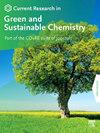从堇菜中绿色合成的金属纳米粒子的特性及其在偶氮染料生物降解中的应用:循环经济方法
Q2 Materials Science
Current Research in Green and Sustainable Chemistry
Pub Date : 2024-01-01
DOI:10.1016/j.crgsc.2024.100434
引用次数: 0
摘要
该研究旨在从堇菜提取物中合成纳米粒子,以生物降解偶氮染料,从而在使用这些染料的行业中实现废物管理的循环经济方法。该研究利用紫外可见光谱和扫描电子显微镜(SEM)确认了纳米粒子的合成并分析了纳米粒子的特性。纳米颗粒的稳定性是通过检测四个因素来评估的:NaCl 的影响、储存条件、温度和 pH 值。将植物纳米颗粒与染料溶液混合、培养,并使用紫外可见光谱分析染料降解情况。抗菌和抗真菌活性采用盘扩散法进行检测。紫外可见光谱证实,Ag-NPs 的合成波长为 450 nm,Au-NPs 为 533 nm,Co-NPs 为 246 nm,Fe-NPs 为 255 nm。Ag-NPs 的平均尺寸为 18.2 nm,Co-NPs 为 22.86 nm,Au-NPs 为 14.9 nm,Fe-NPs 为 43 nm,所有纳米粒子均呈球形。在不同的温度、pH 值和盐浓度条件下,这些纳米粒子表现出极好的稳定性。在六个月的储存期间,这些稳定的纳米粒子将甲基橙的吸光度从 2.7 降解到 1.5。甲基红也发生了降解,其吸光度从 2.8 降至 1.25。研究发现,所有合成的纳米粒子都对革兰氏阴性菌和革兰氏阳性菌具有良好的抗菌活性。不过,金纳米粒子(Au-NPs)的效力最高,尤其是对铜绿假单胞菌,其抑制区直径几乎与商用抗生素链霉素相当。同样,抗真菌试验表明,与其他类型的纳米粒子相比,Au-NPs 对受试真菌菌株的活性最强。本文章由计算机程序翻译,如有差异,请以英文原文为准。
Characterization of metallic nanoparticles synthesized via green synthesis from Viola odorata and their application in azo-dye biodegradation: A circular economy approach
The study aimed to synthesize nanoparticles from Viola odorata extract to biodegrade azo-dyes, enabling a circular economy approach to waste management in industries that utilize these dyes. The study utilized UV–visible spectroscopy and scanning electron microscopy (SEM) to confirm the synthesis and analyze the characteristics of the nanoparticles. The stability of the nanoparticles was assessed through the examination of four factors: the impact of NaCl, storage conditions, temperature, and pH. Plant-based nanoparticles were mixed with dye solutions, incubated, and analyzed for dye degradation using UV–Vis spectroscopy. Antibacterial and antifungal activity were assayed by disc diffusion method. UV–Vis spectrum confirms the synthesis of Ag-NPs at 450 nm, Au-NPs 533 nm, Co-NPs 246, Fe-NPs 255 nm. Ag-NPs had an average size of 18.2, Co-NPs 22.86 nm, Au-NPs 14. 9 nm and Fe-NPs 43 nm and all nanoparticles are spherical in shape. The nanoparticles exhibited excellent stability under varying temperature, pH, salt concentrations, and during six-months storage, these stable nanoparticles degraded methyl orange absorbance from 2.7 to 1.5. Methyl red was also degraded and its absorbance decreased from 2.8 to 1.25. The study found that all the synthesized nanoparticles displayed good antibacterial activity against both Gram-negative and Gram-positive bacteria. However, the gold nanoparticles (Au-NPs) demonstrated the highest potency, particularly against Pseudomonas aeruginosa, with an inhibition zone diameter nearly matching that of the commercial antibiotic Streptomycin. Similarly, the antifungal assay revealed that the Au-NPs exhibited the strongest activity against the tested fungal strains compared to the other nanoparticle types.
求助全文
通过发布文献求助,成功后即可免费获取论文全文。
去求助
来源期刊

Current Research in Green and Sustainable Chemistry
Materials Science-Materials Chemistry
CiteScore
11.20
自引率
0.00%
发文量
116
审稿时长
78 days
 求助内容:
求助内容: 应助结果提醒方式:
应助结果提醒方式:


